
For fuel economy, few machines could match one that has recently been invented in South Africa. The idea of a Pretoria man, Arnold De Beer, this machine runs happily on nothing but solar energy.
By an ingenious yet simple principle, it converts sunpower directly into mechanical energy. The inventor himself uses his original prototype solar-powered pump for pumping water from a 30-ft. deep well.
The fact that it's solar-powered gives it immediate suitability to many farm situations. But it's also designed for do-it-yourself construction by farmers themselves, which means that farmers can immediately take advantage of the idea at low cost.
In fact, De Beer's only commercial exploitation of his invention is through the sale of detailed plans for do-it-yourself construction. He points out that the structural components can largely be salvaged from farm scrap heaps. There are a few specialized parts, like valves, but they are all standard and can be obtained from most hardware stores.
The solar pump is not very efficient at converting the energy it receives. But this is hardly an issue when it comes to solar energy -- there is so much of it anyway.
In bright sunshine, the solar pump can lift almost as much water in an hour as any similar-sized windmill would in a good stiff breeze. It cannot rival the windmill for its maximum performance. But De Beer claims that, in the longer term -- like several months -- his device "outperforms a windmill by far."
He reasons that, in most of the world's localities, there are many more hours of useful sunshine than there are of useful winds. Statistics for Southern Africa, he says, show that the sun shines there for 9 days in 10. On the other hand, only 1 day in 14 will the wind blow strong enough to turn a windmill at maximum speed.
In other parts of the world, the difference is likely to be less extreme. But, with few exceptions, the trend should at least exist to the extent that the same advantage can be claimed.
And even if the longer term performance of the solar pump was only the same as that of the windmill, it has a substantial cost advantage to clinch its competitiveness.
In outward appearance, the solar pump resembles an oversized playground see-saw. A long steel boom swivels on an axle about 42 ft. off the ground. The resultant mechanical energy takes the form of this boom see-sawing about its axle. Rods connect it to the conventional plunger pump in the well -- much like a conventional windmill set-up.
The sun's energy is transformed into mechanical motion by means of a special plumbing system. It's made up of solar collecting panels (high pressure type), a reservoir and a master chamber perched on the long end of the boom.
These three major components are interconnected by a system of pipes. The entire plumbing system is under vacuum and contains only a special heat-sensitive fluid. The fluid -- a refrigerant -- has a very low boiling point.
The relative levels of the three major components ensure that the fluid always gravitates to the solar panel. There is enough fluid to occupy the reservoir, the solar panel and the lower reaches of the piping system.
As the sun's rays hit the panel and raise its temperature, the fluid inside boils and vaporizes. Pressure quickly builds up inside the panel and reservoir. A large pressure differential is created between the reservoir and the master chamber. Fluid is thereby forced from the reservoir to the master chamber which is aloft at this stage.
Over a period of 10-15 seconds in bright sunshine, the master chamber gets filled with fluid and its combined weight is enough to tip the balance.
The heavy chamber plunges downward in a swift power stroke. As the boom hits its lowest position, it trips a strategically located valve switch which opens a second circuit between the two chambers, equalizing pressure between them.
With no pressure difference between them, fluid is allowed to drain away by gravity from the master chamber to the lower reservoir chamber. The master chamber thus empties and, once again lighter than its counterbalance, is sent on its return upward journey.
As it hits the top position, the boom hits the switch again -- this time closing the valve and restoring the original circuit. The master chamber is effectively sealed off again and is ready to receive and hold fluid again for the impending repeat of the charging process.
In bright sunshine, this charging process takes only ten seconds. This is the time it takes for the master chamber to fill and gather sufficient weight to overcome all forces counterbalancing it, including the load imposed by the well pump itself.
For the prototype, each stroke delivers about 4.5 qts. of water from a 30-ft. depth. At six strokes a minute, this makes for an hourly delivery of about 400 gal. This capacity can be increased substantially, without haying to increase the overall size of the structure, by merely increasing the total solar panel area, size of the master chamber and the amount of fluid in the system.
While hot blazing sunshine is ideal for the solar pump's maximum performance, it is not absolutely essential. It will still work-but at a slower rate -- on a moderately overcast day. "The sun still gets through," says De Beer, "and the process is a cumulative one so solar energy is effectively stored as potential energy of fluid collected in the master chamber."
At the point in the process where pressure is suddenly equalized between the two chambers, pressurized vapor escapes into the connecting pipe and master chamber. This vapor must be liquefied by the provision of a condenser in the plumbing circuit. De Beer's do-it-yourself plans explain how an old automobile radiator can be converted for this function.
